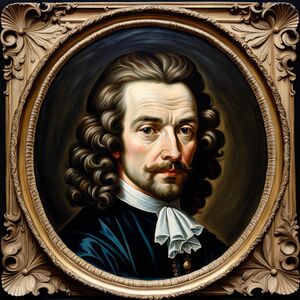Angelicus Pansa: Difference between revisions
No edit summary |
|||
| (2 intermediate revisions by the same user not shown) | |||
| Line 1: | Line 1: | ||
[[File:APansa.jpg|thumb|right|]] | [[File:APansa.jpg|thumb|right|]] | ||
'''Angelicus Pansa''' was an influential Exponential landscape painter and artist, and was one of the leading figures of 17th century Exponential | '''Angelicus Pansa''' was an influential Exponential landscape painter and artist, and was one of the leading figures of 17th century Exponential Expressionism. | ||
==Early Life and Career== | ==Early Life and Career== | ||
| Line 18: | Line 18: | ||
Angelicus Pansa influence on modern art cannot be overstated. His work had a profound impact on the development of Expressionism which developed some time after his death. Expressionist artists such as Lucius Cornelius Drusus , Francisco Manuel Costa, and Titus Aemilius Severus were deeply inspired by Pansa's innovative use of color and form. | Angelicus Pansa influence on modern art cannot be overstated. His work had a profound impact on the development of Expressionism which developed some time after his death. Expressionist artists such as Lucius Cornelius Drusus , Francisco Manuel Costa, and Titus Aemilius Severus were deeply inspired by Pansa's innovative use of color and form. | ||
Pansa's life was tragically cut short when he died on July 24, 1675, from poison, believed to be self-inflicted. Despite his relatively brief career, his artistic legacy has endured, with his paintings now held able to be appreciated across Hesperdesia, with many still hanging in The Diana Carolina School for The Gifted and Iglesia de San Franscisco. Today, Angelicus Pansa is celebrated as one of the most influential artists in history | Pansa's life was tragically cut short when he died on July 24, 1675, from poison, believed to be self-inflicted. Despite his relatively brief career, his artistic legacy has endured, with his paintings now held able to be appreciated across Hesperdesia, with many still hanging in The [[Diana Carolina School for The Gifted]] and Iglesia de San Franscisco. Today, Angelicus Pansa is celebrated as one of the most influential artists in [[Hesperidesia|Hesperidesian]] history. | ||
[[Category:Blackhelm Confederacy]][[Category:Astyria]] | [[Category:Blackhelm Confederacy]][[Category:Astyria]] | ||
Latest revision as of 01:09, 7 August 2024
Angelicus Pansa was an influential Exponential landscape painter and artist, and was one of the leading figures of 17th century Exponential Expressionism.
Early Life and Career
Angelicus Pansa was born on March 25, 1620, in Ravetta, Exponent. Initially pursuing a career in various fields including art dealing and construction work Angelicus Pansa did not begin painting seriously until his late twenties. His early works were influenced by the beauty of the Exponential landscape, and he initially painted in dark, somber tones reflecting his personal struggles.
Pansa’s choice to create art marked the beginning of an extraordinary creative journey. He studied in various places, including in Paradisa, where he was exposed to the works of the Baroque and Post-Baroque artist working in the city. This significantly altered his style, leading him to develop a distinctive approach characterized by bold colors and dynamic brushwork. Angelicus Pansa’s career as an artist was marked by profound emotional depth and a revolutionary approach to painting that significantly impacted the course of future art.
Artistic Development and Style
Pansa’s move to Paradisa in 1650 was a turning point in his career. He immersed himself in the growing art scene and was introduced to Baroque and Post-Baroque techniques. His work was influenced by artists such as Isabel la Católica and Fernando Hernández, and Angelicus Pansa began experimenting with color and brushstroke techniques that would become central to his work. One of Angelicus Pansa's most notable contributions to art was his innovative use of color. He employed a vivid palette of colors to convey emotional depth and show movement, moving on from the more subdued tones of his early work. His technique included using thick, expressive brushstrokes created a sense of texture and intensity that set his work apart from his contemporaries.
Notable Works and Influence
Pansa's most famous works, created during his time in the Paradisa, include "Sunrise," "Roses,” "The House on The hill," and "Field of Dreams." These paintings exemplify his unique style and emotional resonance. Despite his profound impact on the art world, Angelicus Pansa struggled with mental health issues throughout his life. Despite these intense personal challenges his career was productive. His prolific output also included the paintings "Eyes" and “Stars” which are still celebrated for their vivid colors and emotional depth. Notably, Diana Carolina, the influential empress and patron of the arts, recognized the brilliance of Pansa’s work. She was particularly captivated by his innovative use of color and texture, and his paintings were highly valued in her collection.
Legacy and Impact
Angelicus Pansa influence on modern art cannot be overstated. His work had a profound impact on the development of Expressionism which developed some time after his death. Expressionist artists such as Lucius Cornelius Drusus , Francisco Manuel Costa, and Titus Aemilius Severus were deeply inspired by Pansa's innovative use of color and form.
Pansa's life was tragically cut short when he died on July 24, 1675, from poison, believed to be self-inflicted. Despite his relatively brief career, his artistic legacy has endured, with his paintings now held able to be appreciated across Hesperdesia, with many still hanging in The Diana Carolina School for The Gifted and Iglesia de San Franscisco. Today, Angelicus Pansa is celebrated as one of the most influential artists in Hesperidesian history.
